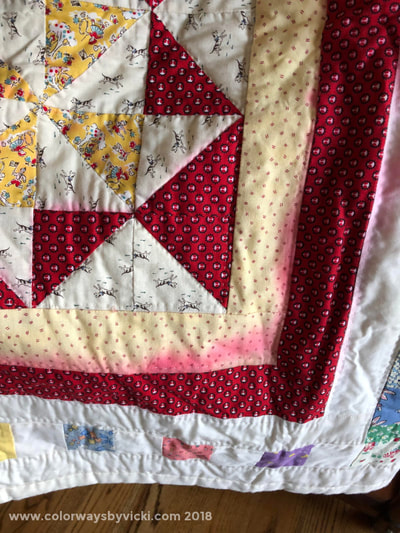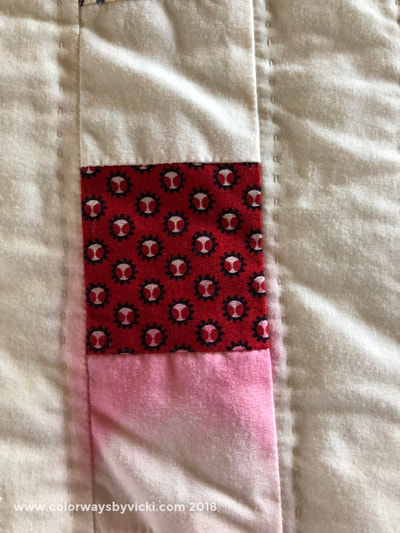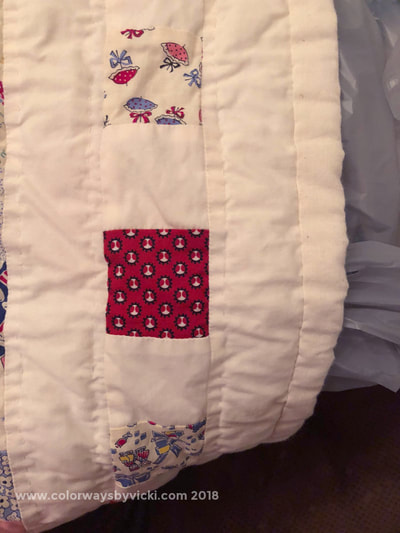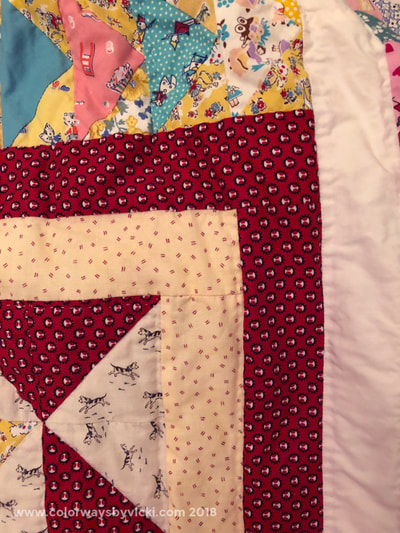|
Because of my Save My Bleeding Quilt article, this topic comes up a lot for me. It's also a bit of a pet peeve. There's SO MUCH BAD INFORMATION out there about dealing with bleeding fabrics and about how to process hand dyed fabrics so that they don't bleed. It annoys me no end so I will continue to talk about it any time I get a chance. When I was vending at Birds of a Feather I had a free handout in my booth to help continue spreading the word. It was there that I met Rhonda M from Houston. Her home was flooded during Hurricane Harvey and one of her quilts bled when she washed it. I gave her the handout and talked her through the soaking process to try to get the dye out of her quilt. It doesn't work all the time but it works best when the bleeding is spotty like this. Another reader recently had a quilt that turned an even pink all over so that meant that the other fabrics in the quilt really wanted that dye and absorbed it. She was able to get about half of the pink out but not all of it. But Rhonda has much better luck! All of the dye came out of her quilt and she's happy again. These stories make me very happy too. I get at least one query or story every week about dealing with bleeding quilts. It's really sad because this can all be avoided by soaking fabric, using my process, as soon as it comes into your house.
I've decided that today I want to try to address some of the specific comments that I've seen lately on Facebook and some information that I heard in an online dyeing class. About commercial fabric and quilts: Just giving a quilt with some color catchers is not a very nice way to gift a quilt but it seems the favorite Facebook way to gift a quilt. If you are worried about a quilt bleeding please take the time to either soak the fabrics before you make the quilt or soak the quilt before you give it. Color catchers aren't going to prevent or fix a bleeding problem. They look really cool but it's the soap that does the work. Let's say you gift a quilt and it bleeds the first time the recipient washes it do you think they are going to tell you that they ruined "your" quilt? No! They are going to stuff it in a closet and hope you never ask about it again. It will eventually be used for moving pads or pet bedding. They will never know that it could probably be fixed. Soap and water are the key and you need plenty of both. A soap molecule is hydrophilic on one end and hydrophobic on the other. The hydrophilic end really wants to attach to a water molecule. The hydrophobic end hates water and looks for something else to attach to. That something else might be dirt, oil or loose dye particles. That means that you need lots of water molecules and lots of soap molecules to pick up all of the loose dye molecules. If that dye doesn't get attached to a water molecule it's going to attach back to the fabric. You can't fix a bleeding fabric or quilt in a HE washing machine. There simply isn't enough water. Time is also important. Some dyes take a while to let go. Blues are especially notorious. Soak a minimum of 8 hours to make sure that the fabric isn't going to bleed. This is why simply pre-washing fabric will not work. I recently bought a commercial purple fabric. I washed it once just to test my theory. I put in a color catcher to see if it bled in the wash. It didn't. Then I soaked it overnight and by morning the water was DARK purple! It was eventually going to bleed during one of the washings had I not soaked that fabric because exposure to water is cumulative. Any Dawn detergent will do. There's nothing magical about Blue Dawn! I compared the ingredients on all of the Dawn products and they should all work equally fine. I only tested the Dawn Pure Essentials but would use whichever is closest. Dawn does work better than Synthrapol and is a lot less expensive. Don't use Retayne to fix a bleeding quilt! Retayne "retains" dyes. That means that if there's loose dye in the water the Retayne will do a great job of attracting that loose dye back to your quilt and not necessarily where it came from. Retayne was developed for fabric dyers and I learned the hard way that you can only use Retayne on single color fabric. Regarding hand dyed fabrics: If you dye or purchase hand dyed fabric the same rules about water, soap and time apply. Here's the process I use to make sure that my fabrics are colorfast. With this process I can wash all of my fabrics together with no back staining. I wash yellows and dark blues together with no problem. 1. Rinse the fabric in cold water first to remove any soda ash. Put the fabric in a bucket or sink of cold water while you rinse out all of your fabrics. 2. If the fabric is very dark I might run through a couple of quick cold soaks to get some of the quick releasing dye out. Once the water is dark I drain. 3. Fill a large tub or sink with HOT water and enough soap to get a good suds. Add the fabric and agitate the fabric wearing heavy gloves. Cover the fabric with plastic bin lid and weight them with bins of water. You want all of the fabric under water. 4. Check the water in an hour. If the water is dark drain it and fill the tub again with HOT water. Check in a few hours and repeat if necessary. 5. Leave the fabric to soak 12 hours. Change the water and soak 12 more hours. Do this every 12 hours until the water is clear. Yellows and oranges will be done within 12 hours, reds generally take 24 - 36 and turquoise and cerulean blues can take 48 hours. If you follow this you will have colorfast hand dyed fabric that you can safely use in any project. OK, I feel better now that I've got all of that off my chest and it's time for me to rinse out yesterday's dyed fabric.
Claire Christiansen
3/8/2018 11:04:10 am
I've used your method successfully several times. Usually blocking a quilt brings up the issue so I quickly put the binding on and then proceed to the bathtub. Good-bye horror!
Liz
3/8/2018 11:04:47 am
Thanks for the information. This page is now book marked so I can find it again!
patty
3/8/2018 12:17:26 pm
I wish I would have know you and this method 16 - 17 years ago when I made someone a yellow and blue quilt. I washed it before I sent it to her and when I came out of the washer it was blue and lime green! I scrubbed and scrubbed that quilt to try and get some of the blue out of the yellow fabrics. Had I only know .... even though my HE washer wasn't broken I got rid of it within a couple years after I bought it and realized I couldn't soak quilts in it - I don't have an extra bathroom with tub to use and no where else to soak a quilt if I have not tested fabric - I know I should soak all my fabric now (before it goes in a quilt) overnight but I use so many small scraps and do not know what was washed and what wasn't that I usually have to take care of it after the quilt is made - but I always take care of it before I pass it on to someone else.
Quilting Tangent
3/8/2018 02:12:07 pm
Thank you!
I’ve used your methods several times, and they’ve worked well. I just had that one junky fabric that glommed onto the loose dye and wouldn’t let go.
Pam
3/8/2018 06:58:17 pm
You are my hero. I have used your method and referred others to it. I know that you a stickler for details and keep detailed notes. I trust you and your testing.
Fran
3/8/2018 08:29:40 pm
I have given presentations about your method of washing quilts and fabrics. I follow your method and have never have bleeding issues. So many people do not prewash fabrics and will not heed the message,...until they suffer a bad case of the bleeding quilt. Teachers often advocate not washing fabrics, so it seems that many would rather take the risk—until that one heirloom quilt is affected. No matter...I will keep praising your research and advocate your methods and point people to your article, and, most definitely, keep using your method. Thanks for the time you have devoted to this. I, for one, greatly appreciate it. I just talked about your tutorial this week at a quilter's meeting, and gave your website address so they can look it up. A fellow quilter had a quilt where the red had bled, and was talking about prewashing. Thanks so much for your efforts on this subject, and your tutorial!!
Gene Black
3/9/2018 08:13:56 am
For a while, I thought that color catchers were "the way" to keep away bleeding. Since I found your blog a few years ago, I learned the right way. Besides saving me a lot of $$ on color catchers - you have saved a lot of my fabric that I just wouldn't use because it bleeds. I did a major "soak session" with the offending (bleeding) yardages. Now I can use them without worry.
Kristin F
3/9/2018 10:36:25 am
Thank you, Vicki, for your very informative article! I did not know about the soap molecules and found that interesting. I always prewash my fabrics (now in an HE machine) and figured that was enough. I guess not!
Andrea
3/9/2018 12:05:08 pm
Your research has been invaluable to me - thank you. I've used this for things I've dyed and for commercial fabrics, too. People are always surprised when I tell them the tie dyed shirts are safe to wash with anything. :)
LJ
3/10/2018 09:55:01 am
Thanks, Vicki. I save your notes - these and previous notes - and know that you are the expert. I've only had the issue of bleeding once (Thank God.) but following your directions took care of the situation perfectly.
Jo Vandermey
3/11/2018 04:25:12 pm
I have sent several people to your blog post on this topic. It is the best. Whether it is a hand dye or a commercial fabric I never trust anything. You are a " Rock Star" in my world!
Nancy Sumner
4/9/2018 11:35:45 pm
So very helpful. I have successfully removed bleeding from a quilt thanks to you!
Carol
4/15/2018 12:48:31 pm
I am constantly surprised that so many experienced quilters don't pre-wash fabric. I've never tried soaking, but it sounds like a good method, especially for deep colors and batiks. I'm thinking I could buy a plastic trashcan solely for this purpose since the newer "High Efficiency" washing machines are so stingy with water. Comments are closed.
|
FeedsTo subscribe click the RSS Feed button and copy the URL of that page into your blog reader.
In Bloglovin you need to search "Colorways By Vicki Welsh" to find the blog. About Vicki
I'm Vicki Welsh and I've been making things as long as I can remember. I used to be a garment maker but transitioned to quilts about 20 years ago. Currently I'm into fabric dyeing, quilting, Zentangle, fabric postcards, fused glass and mosaic. I document my adventures here. Categories
All
Archives
July 2024
|




 RSS Feed
RSS Feed